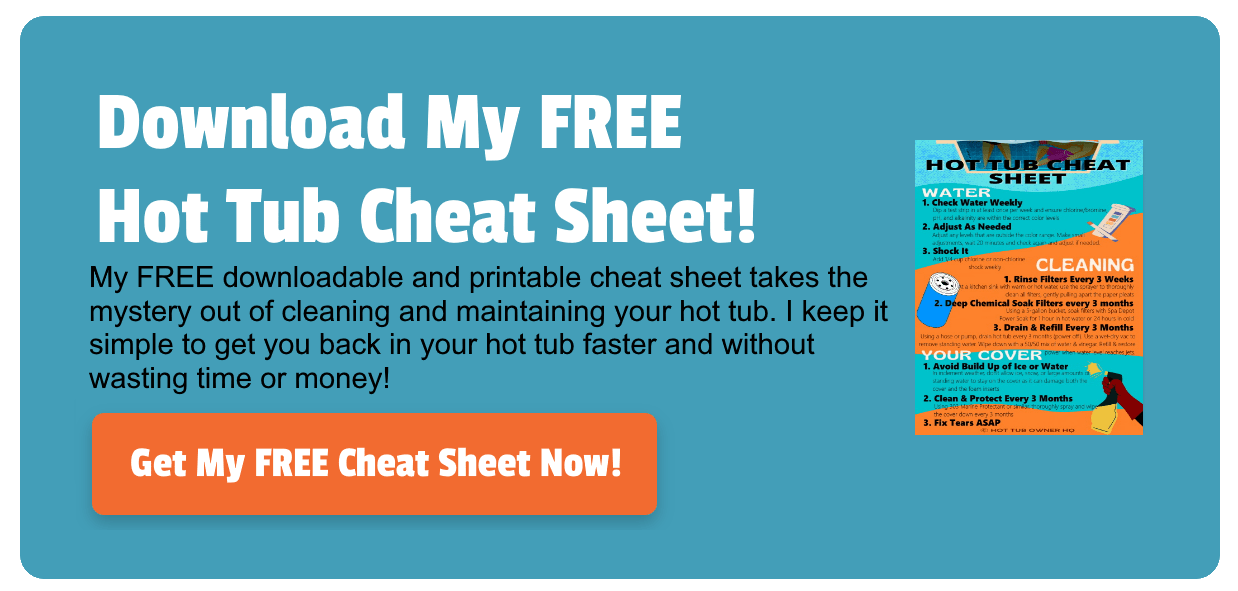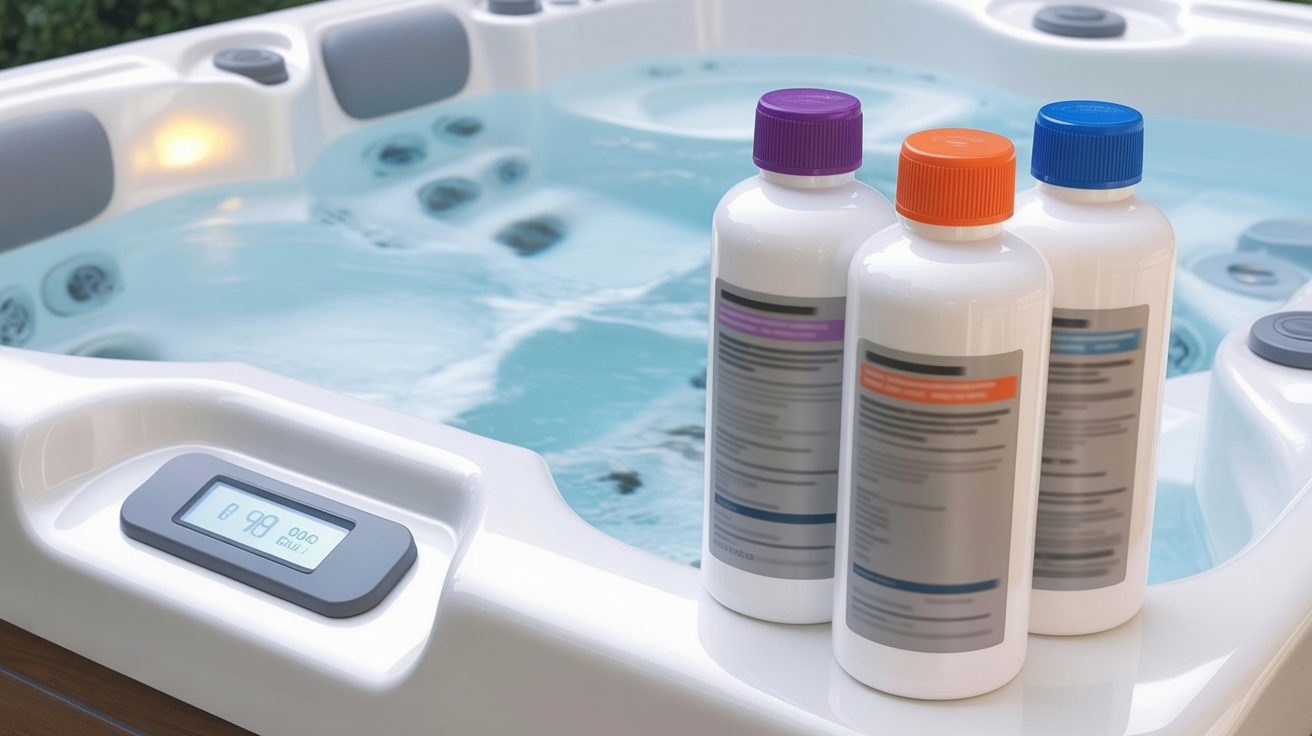If you own a hot tub, you know how important it is to keep the water clean and sanitized. But, you may be asking “do I really need to shock my hot tub?”
Yes. Adding a weekly shock treatment is an essential part of hot tub maintenance that ensures that the water stays clean, clear, and free of harmful contaminants.
In this expert guide, we will explore the benefits of hot tub shock treatment and provide tips on how to properly care for your hot tub water. From understanding the importance of hot tub sanitizers to knowing when and how often to shock your hot tub, we’ve got you covered.
Ready to Spend Less Time On Maintenance and More Time Enjoying Your Hot Tub?
Let’s face it. Balancing the water, cleaning filters, dealing with rashes, and trying to figure out which chemicals to buy and add can make you feel more like a chemist than someone who just wants to relax after a long hard day!
That’s exactly why The Hot Tub Handbook and Video Course is so valuable!
This is from Matt over at Swim University and he developed it for people looking to save money, time, and frustration. His tips on chemicals can save you $100/year just by making sure you buy only what you need.
So if you’re ready to stop being confused or frustrated with your hot tub and start spending more time in it, check out The Hot Tub Handbook and Video Course.
Just click that link to learn more on their website.
What Is Hot Tub Shock?
Hot tub shock is a concentrated chemical treatment designed to eliminate organic contaminants and restore water clarity in your spa water. Think of it as a powerful cleaning boost that goes beyond regular sanitizer levels.
There are two main types of shock treatment.
Chlorine-based shock (like sodium dichlor) uses active chlorine to oxidize organic waste and boost free chlorine levels. Non-chlorine shock treatment (potassium monopersulfate) oxidizes contaminants without affecting your existing sanitizer levels.
Hot tub shock treatment works through a chemical reaction that breaks down organic matter into harmless compounds. This process restores water balance and prevents harmful bacteria growth that thrives in poorly maintained spa environments.
Regular shock treatment is essential for maintaining clear water and ensuring an enjoyable experience. Without it, even the best circulation pump and filtration system can’t keep up with heavy bather loads or frequent use, leading to water quality issues that make your home spa less inviting.
In fact, over the years, I have owned 4 hot tubs and have had to become pretty familiar with the best hot tub chemicals to use.
Check out my top recommendations right here on my website.
When to Shock Your Hot Tub
You should shock your hot tub weekly as part of regular maintenance to maintain water quality. This consistent schedule helps eliminate organic contaminants before they build up and cause water issues.
However, heavy usage situations require additional shock treatments beyond your weekly routine. After a hot tub party or multiple bathers in one session, body oils and dead skin cells accumulate faster than your bromine sanitizer or chlorine can handle alone.
Signs that indicate you need extra shock include:
- cloudy water
- unpleasant odors
- when your sanitizer levels won’t stay balanced despite proper chemical dosing
These symptoms show that organic compounds have overwhelmed your normal hot tub maintenance routine.
The best times to shock are in the evening when no one will use the spa for several hours. This allows the shock treatment to work effectively without interference from bathers.
Is Chlorine Shock Better Than Non-Chlorine Shock?
Neither chlorine-based shock treatment nor non-chlorine shock treatment is universally “better” – the best option depends on your specific spa water needs and maintenance preferences.
Chlorine-based shocks like sodium dichlor oxidize organic compounds while temporarily boosting sanitizer levels. However, shock treatments break down quickly and don’t replace your regular sanitizer routine – you still need to maintain proper sanitizer levels separately.
Non-chlorine shock treatment using potassium monopersulfate focuses solely on oxidizing organic contaminants like body oils and dead skin cells. This type of shock works effectively with any sanitizer system, whether you use chlorine granules or bromine sanitizer.
For regular maintenance, non-chlorine shock often provides excellent water clarity without interfering with your established sanitizer levels. Chlorine-based shock can be useful when dealing with heavy usage situations that overwhelm your normal sanitizer capacity.
The main reason to choose one over the other relates to your maintenance goals.
Non-chlorine shock gives you precise control over water chemistry while eliminating organic matter. Many people also find less of a chlorine odor with non-chlorine shock, and find it gentler on the skin.
Chlorine-based shock provides additional oxidizing power when organic compounds are particularly stubborn.
Both types effectively restore water quality when used according to manufacturer’s instructions, making either option suitable for your hot tub maintenance routine alongside regular sanitizer dosing.
Can You Use Chlorine Hot Tub Shock With Bromine Sanitizer?
Yes, you can safely use chlorine-based shock treatment with bromine sanitizer in your hot tub water. This combination is a common and effective practice for maintaining water quality.
When you add sodium dichlor or other chlorine-based shocks to a bromine system, the active chlorine reacts with existing bromide ions to create more active bromine. This actually enhances your bromine sanitizer’s effectiveness rather than interfering with it.
The main reason this works well is that chlorine and bromine complement each other in spa water. Your regular bromine level continues doing its sanitizing job while the chlorine shock eliminates organic compounds like body oils and dead skin cells.
Many hot tub owners prefer this combination because chlorine-based shock treatments are often more readily available and cost-effective than non-chlorine shock treatment options. Following manufacturer’s instructions ensures proper water balance and chemical levels.
You should still maintain your regular bromine sanitizer routine alongside weekly shock treatments. This approach provides excellent water clarity and eliminates organic contaminants that cause cloudy water and unpleasant odors.
Whether you choose chlorine-based shock or potassium monopersulfate, both work effectively with bromine systems as part of your hot tub maintenance routine.
How to Shock Your Hot Tub
Start by removing your hot tub cover and then testing your hot tub water with test strips to check pH levels and sanitizer levels before adding any shock treatment. Proper water balance ensures maximum effectiveness of the shock treatment.
Then turn on the circulation pump to ensure proper water movement during the process. Choose your type of shock – either sodium dichlor for chlorine-based shock treatment or potassium monopersulfate for non-chlorine shock treatment.
Follow manufacturer’s instructions for dosage based on your spa water volume. But typically, you’ll be adding about 2 tablespoons of shock once a week.
Most hot tub shock comes in granular form that dissolves quickly when sprinkled directly into the hot tub water while the pump runs.
Never add shock chemicals when people are in the spa. This is an important step for safety and allows the active ingredient to work without interference from body oils or organic contaminants.
Run your circulation pump for at least 15-20 minutes after adding the shock to ensure complete mixing and distribution throughout your spa water. Keep the hot tub cover off during this time to allow proper ventilation.
Wait at least 15 minutes before testing chemical levels again. Don’t use the spa until sanitizer levels return to normal range, typically 1-3 ppm for chlorine or 3-5 ppm for bromine sanitizer.
How Long Should You Wait to Soak After Shocking a Hot Tub?
For non-chlorine shock treatment using potassium monopersulfate, you typically need to wait 15-20 minutes before safely soaking.
With chlorine-based shock treatment like sodium dichlor, wait at least 20 minutes, then use test strips to check your sanitizer levels. Your hot tub water is safe when free chlorine levels drop to 1-3 ppm or bromine sanitizer reads 3-5 ppm.
But with chlorine shock, those safe levels might sometimes take a few hours to reach. That’s why I prefer to shock mine when I know I’m done for the day.
Never enter the spa while shock chemicals are still actively working in your hot tub water. High chemical levels can cause skin and eye irritation, making your soaking experience anything but enjoyable.
Keep your circulation pump running during the waiting period to ensure proper mixing and distribution of the shock treatment. This helps achieve clear water faster and ensures accurate readings when you test chemical levels.
The main reason for waiting is allowing the active ingredient time to neutralize organic compounds while chemical levels return to safe ranges for human contact.
Final Thoughts
Regular shock treatment is essential for maintaining water quality and preventing cloudy water in your hot tub. Without weekly shocking, organic contaminants from body oils and dead skin cells will overwhelm your sanitizer levels and create an unpleasant soaking environment.
Whether you choose chlorine-based shock treatment or non-chlorine shock treatment, both effectively eliminate organic compounds that cause water issues. The key is consistency in your hot tub maintenance routine.
Your spa water depends on this crucial step to stay clean and safe. Skipping shock treatments leads to problems that are much harder and more expensive to fix later.
Make shocking part of your regular maintenance schedule. Your hot tub will reward you with crystal clear water and an enjoyable experience every time you soak.
Ready to Spend Less Time On Maintenance and More Time Enjoying Your Hot Tub?
Let’s face it. Balancing the water, cleaning filters, dealing with rashes, and trying to figure out which chemicals to buy and add can make you feel more like a chemist than someone who just wants to relax after a long hard day!
That’s exactly why The Hot Tub Handbook and Video Course is so valuable!
This is from Matt over at Swim University and he developed it for people looking to save money, time, and frustration. His tips on chemicals can save you $100/year just by making sure you buy only what you need.
So if you’re ready to stop being confused or frustrated with your hot tub and start spending more time in it, check out The Hot Tub Handbook and Video Course.
Just click that link to learn more on their website.
As an Amazon Associate, I may earn a small commission from qualifying purchases if you click on Amazon from my site and choose to make a purchase. You can read my complete affiliate disclosure for more details.
- Do Hot Tub Enzymes Work? (Better Than Chemicals?) - July 28, 2025
- How Do You Know if Your Hot Tub Sanitizer is Working? - July 28, 2025
- Do I Need to Put Algaecide in My Hot Tub? - July 27, 2025




